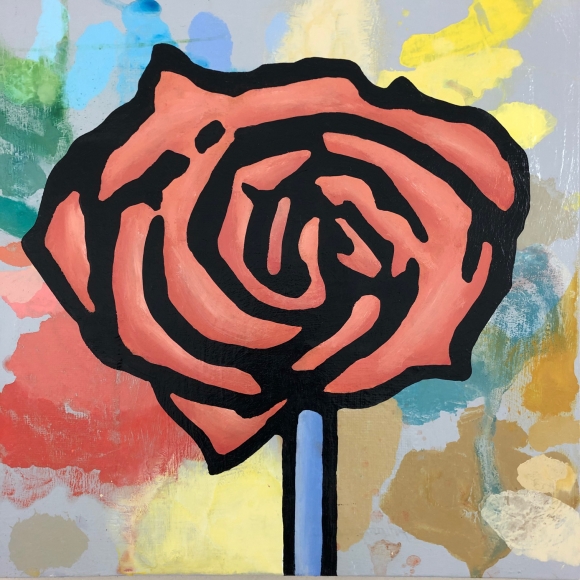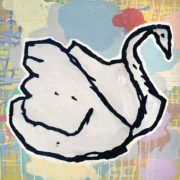“Donald Baechler – Remedy of Anything” Exhibition at McClain Gallery




 +3
+3 “Donald Baechler – Remedy of Anything” Exhibition at McClain Gallery
“Donald Baechler – Remedy of Anything” Exhibition at McClain Gallery
“Donald Baechler – Remedy of Anything” Exhibition at McClain Gallery
“Donald Baechler – Remedy of Anything” Exhibition at McClain Gallery
“Donald Baechler – Remedy of Anything” Exhibition at McClain Gallery
“Donald Baechler – Remedy of Anything” Exhibition at McClain Gallery
Through the years, people rooted around for dark or negative associations in Donald Baechler’s cartoonish depictions of roses and ice cream cones. His paintings denote death, some said, roses die and ice cream melts. Or they parody his comfy Hartford Connecticut suburban upbringing. Or, constitute political ranting, surely he’s bitchin about something. At the very least, they challenge art’s high-mindedness. Positioning a crudely-rendered exceedingly ordinary object in the center of a classic “figure-ground” Mona Lisa-type composition, with collaged mug shots in the background, confronts lofty art-hierarchical notions and knocks fine art off its throne.
Not really. Baechler knows roses die. He wasn’t thinking about that, he happens to like roses. Nor is he squawking about political or social issues. His childhood on Farmstead Lane was a happy one. Rather than dishonoring fine art, he appreciates it, and possesses extensive art historical knowledge.
McClain Gallery is presenting its fourth solo exhibition of artworks by Baechler. “Donald Baechler – Remedy of Anything” includes small scale 24 x 24 inch paintings and graphite drawings through August 21, 2021. Here’s what I know about this artist. His typical process is to build up an uneven surface with layers of paint and with scraps of paper and fabric. He fiddles quite a bit with the surface, applies paint thickly, blots and erases, scrapes off, adds more. Collage fragments, some with personal meaning, a Picasso drawing, a bar tab, Egyptian temple receipts, become important components of the surface. He then paints a large-scaled colored image of a mundane object outlined in black in the foreground. The bumpy textured surface interrupts his painted line and gives it a scribbly childlike quality, and this disruption of line interests Baechler a great deal, it’s “a critical part of the method.” In the end, a cartoony coloring-book style foreground image sits somewhat uneasily against a textural mixed-media background.
This reinvention of the image made him a biggie in contemporary art. You know you’re big when that weirdo Warhol cranks-out your portrait. “New Yorker” mag called Baechler, “one of those eighties honchoes.” He enjoys prestigious gallery representation in New York, and abroad, has had numerous museum shows, and his art is in the permanent collections of the Museum of Modern Art, Whitney Museum of American Art, Guggenheim Museum, Museum of Fine Arts, Boston; Stedelijk Museum, Amsterdam, Centre George Pompidou, Musée National d’Art Moderne, Paris; and Städtische Galerie Schloss Wolfsburg, Germany.
Baechler’s paintings began raking-in over six figures back in about 1999. In 2008 a rich patron forked over the bucks for the Museum of Fine Arts, Houston to acquire “Hundred Pound Ice Cream Cone” (1998) for its permanent collection. I don’t know if that generous donor had paintings by Baechler in his own collection, but if he did, it wasn’t dumb to hitch another museum collection to Baechler’s resume by “funding” MFAH’s purchase.
I had the chance to write a newspaper article about Baechler’s 2009 McClain Gallery exhibition. I called him a “market-hypnotizing eighties star, part of a loose gaggle of New York-based new figuration mi-lords,” rightly suggesting he participated in the post-modern redefinition of the image. Although not in the provocative crack-pot way some others did. Art, of course, breeds high-fallutin labels. Pushing the boundaries of figurative pictorial construction got termed new image painting and neo-expressionism.
At the time Baechler was becoming successful, the art market was stratospheric, and the art world had the veneer of an inner sanctum. One saw a few lordly characters. Baechler on the other hand is gentlemanly and kind. In 2009, this ordinary guy told us at McClain that he includes in his art the kind of things he likes to have around him. He’s unconcerned with narrative or politics, or other things people read into his paintings, he is simply working with line and form. Essentially, he is dedicated to exploring artistic processes and materials.


































